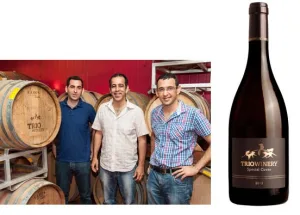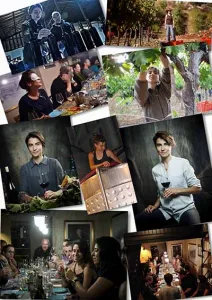My own personal great Port experience is comparatively recent. A bottle of Port was given to my son David, every year on his birthday, by a generous Godmother. It was laid down at Berry Bros of London, wine merchants since 1698, until he came of age. She had no idea he would end up in the wine trade and eventually be one of only a handful of Israelis to gain a WSET Diploma. In his late twenties, David sold most of the Ports, via Berry Bros, to allow the purchase of some good Bordeaux and Burgundies, but he kept two of them. One was Warre’s Vintage Port 1977. We drank it in 2014 carefully decanted into one of my grandfather’s cut glass decanters. The wine was amazing, if not sensational. It was so fresh, so exquisitely balanced, that we drank the bottle during a meal and finished it without really being aware of it. Yes, it was sweet, but it was at the same time refreshing.
This experience encouraged us a couple of years later to open the Taylor’s 1980. This was a big mistake. It was closed and obviously we had committed infanticide by opening it far too young, because it needed far more time to come to itself. The Warre’s was a revelation, the Taylor’s a disappointment, because of our over eagerness, rather than the wine itself. These two experiences brought home to me the unique aging properties and sheer potential of Vintage Port.
Port echoes through the family folklore. Over 150 years and six generations ago, my distinguished forebear, Sir Moses Montefiore, wine lover and connoisseur, used to drink a bottle of Port every single day and he lived to his 101st year, which was way above the life expectancy of the period. In the hours just before he passed away, the story is that he enjoyed three glasses of port! A great way to go!
After his first visit to the Holy Land in 1827, he became a strictly religious Jew and Port became the tipple of his choice. I imagine he had one pipe (550 liter barrel) of Port made at a time, which was then shipped to England. I have often wondered whether the wine was kosher or not. We observe how the rules of kashrut have become so much stricter in our time. Maybe they were laxer in those days?
Even though Montefiore’s nephew, Nathaniel Rothschild, purchased Chateau Mouton Rothschild and the wider family drank what they called ‘Claret’ and ‘Hock’, he chose to stay with Port. Was this because it was fortified with added spirit, an alternative to being ‘mevushal’ or pasteurized? Kosher wine should be handled only by Jews. There were crypto Jews in Porto. Possibly one of them made the wine for him. Or maybe there was a more creative solution. There is a Halacha (Jewish religious law), that says add honey to a wine and it would no longer regarded as wine. Did Montefiore instruct the winemaker to add a spoon of honey to the barrel, which would not have been noticeable on the taste?
It has intrigued me for years. I would be certainly be interested to hear what theories Rabbis, Kashrut experts or historians have to say on the matter. The preference may have been simply because he liked Port, which was the choice of the Brits and it is possible he was influenced by being a member of the Spanish and Portuguese Jewish Community. It could be he agreed with Samuel Johnson, who was quoted as saying: “Claret is the liquor for boys, but Port is for men.” We just don’t know, but it remains a riddle I have not been able to answer.
The history of Port was forged over centuries. In 1703 Britain and Portugal signed the Methuen Treaty, reducing duty on Portuguese wine. Then Britain and France were at odds, and a trading triangle grew, which included dried salted cod from Newfoundland, textiles from Britain and Port wine from Portugal. They swiftly discovered that the Port would be more stable if brandy was added, before being shipped, and the famed fortified wine was born. The Douro Valley was demarcated as an official, protected region in 1756. The wine received its name from the sea port city of Porto, where the wines were matured and shipped. In Britain, Port became the most popular wine, before the rise of Claret.
Port comes from the Douro Valley, in north east Portugal. The most famous grape used for port is the Touriga Nacional. Others used are Tinta Barroca, Tinta Cao, Tinta Roriz and Touriga Francesca. The wine is usually 18-20 % alcohol. The main different Ports are as follows:
Ruby Port is bright, fruity, sweet and simple, with no subtlety and complexity. It is meant to be drunk young, and if there is a Port found in a basic bar, it will most likely be a Ruby Port. From my youth in the British pub scene, popular drinks were Port and lemon, or for those sickening seeking a ‘pick me up’, Port and Brandy. These would only be made using Ruby Port.
Tawny Port is a barrel aged Port. The color is mellowed by aging and oxidation, hence the name. Often, they carry an aged statement on the label. A bottle not showing an age may be not worthy of the name, however if it has an age statement, say 10 or 20 year old, it will be rich, with a nutty, dried fruit character.
LBV – Late bottled Vintage – is a wine from a single vintage that is usually be aged in barrel for a minimum of four to six years. It is richer and far more rewarding than the basic Ruby, and will be less expensive than its elder brother.
Vintage Port will only be produced in special years, when a vintage is ‘declared.’ They are aged in barrel for only 2-3 years, and then cellared in bottle for over 20 years. When opened, the wine has to be decanted off its sediment, and then should be drunk in one sitting. The wines are rich, velvety, complex and warmly satisfying. In British Port culture, it is enjoyed at the end of the meal, and the decanter may only be passed to the left. If you are at a British dinner party and someone vacantly asks you “Have you seen the Bishop of Norwich?”, you should immediately check that the decanter has not stopped in front of you, and pass it on. To the left, of course!
White Port. There is also a White Port made from white grape varieties, which is sometimes served ice cold as an aperitif. It is popular in the summer in Portugal.
Port should be served in small tulip wine glasses (not dissimilar to the Sherry Copita), or a white wine glass will do. Serve it just slightly cooler than room temperature. Port is classic with walnuts, strong flavored cheeses and chocolate dishes. A pairing made in heaven is to match a Vintage Port with a rich, ripe Stilton cheese. Perhaps best of all, is to sip it after dinner.
However, until recently, despite a lifetime in the wine trade, I had never visited Port country. That was until I was fortunate enough to come across the company Wild Douro, with the charming Marta Marques, who is incredibly attentive, smoothly professional with great attention to detail
We visited the Douro Valley, one of the most stunning looking wine regions there are. I knew I had arrived when I saw the red vesper with a wooden case of port strapped to it, ready for delivery. The driver had nipped in to a coffee shop for a coffee. We took a boat up stream, aping the beginnings of the journey the barrels of wine would take to the Vila Nova de Gaia, where the wines would rest and mature, before being shipped from Porto. The schist soil vineyards plunge towards the water in winding, undulating terraces. The sun on the vineyard slopes revealed changing colors which changed each second.
The British were not only the main consumers of Port, but also the main producers. Iconic names like Cockburn, Croft, Graham’s, Sandeman and Taylor’s don’t just sound British, they are! Thus, the very fabric of the British way of life has seeped into the Douro Valley and these British brands became the voice of Port to the world. Of the famous Portuguese Port families, there is none more well-known than the Ferreiras. Incidentally Ferreira (and the similar Perreira) were names also once associated with the Jewish community in Portugal. It makes one wonder if there are hidden, forgotten Jewish roots somewhere!
We visited Quinta Do Vallado, built in 1716, the winery owned by the Ferreira family. They are descendants of the matriarch Dona Antonia, who was one of the great Port figures of the 19th century.
They made Ferreira Ports for 200 years. When they sold the brand, they continue to make Ports under the Vallado brand name. We saw the lagars, where energetic young men still lock arms and tread on the grapes as their ancestors did centuries before. The Vallado Tawny Ports, filled in squat spirit type bottles, were rich, nutty, but not cloying. The nose of the 20 year old reminded me of Christmas cake, with dried fruit soaked in brandy, and subdued notes of toffee. The 40 year old was similar, broader with more treacly notes. Funnily enough, I was not alone in preferring the 20 year old. It was simply more harmoniously balanced. However, you don’t have to make a choice. Both were outstanding.
We also visited the Quinta Nova, whose property dates back to 1725. Here gently pressing technology has replaced the bare foot stompers. The Quinta Nova LBV was good value, showing elegance, good fruit, a splash of chocolate and an easy drinkability. Their Nova Vintage Port was opened in the tradition way using red hot tongs. It was then gently decanted. The wine itself was dense and concentrated, but showing fresh showing red and black fruits, a velvety elegance and some bitter chocolate notes.
Both were strongly into wine tourism, with accommodation, and the Quinta Nova Restaurant was excellent. However, we stayed in the beautiful Douro Palace Hotel Resort & Spa. We arrived after dark, so it was a wonderful surprise to open the curtains to find your room was literally sitting on the Douro River, so one could enjoy the views of a lifetime, whilst wiping the sleep from one’s eyes.
Port wines are rich and satisfying. The history of the region is long, and the heritage has been passed down through generations. The Douro is breathtakingly beautiful. If the region is not on your ‘must visit’ list, it should be!
Adam Montefiore has advanced Israeli wines for over thirty years. He is the wine writer of the Jerusalem Post. www.adammontefiore.com
The writer was a guest of El Al Airlines, the Portuguese Embassy in Israel and Wild Douro on a visit to the Douro in Portugal.


















